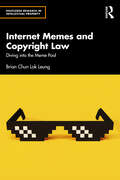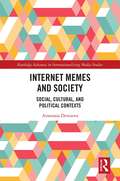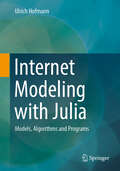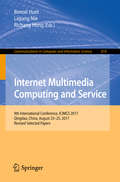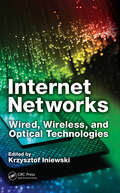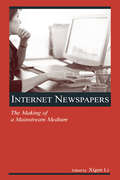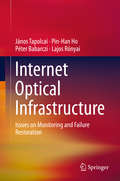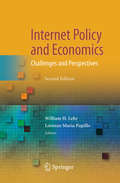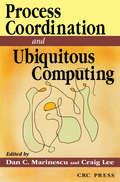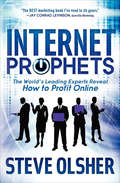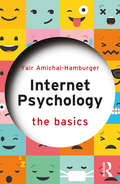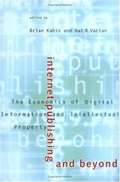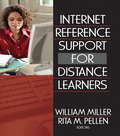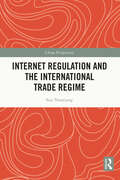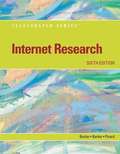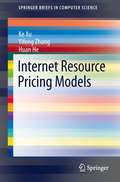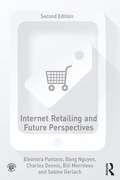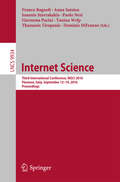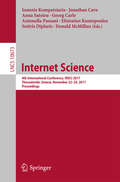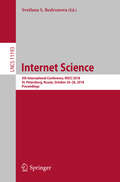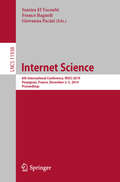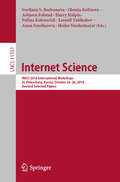- Table View
- List View
Internet Memes and Copyright Law: Diving into the Meme Pool (Routledge Research in Intellectual Property)
by Brian Chun LeungThis book explores the intricate relationship between copyright law and internet meme culture, challenging an assumption that copyright is a barrier to digital creativity.Using the lens of internet memes to analyse copyright law in the context of participatory remix culture, the book confronts a common perception that copyright is the 'destroyer' of internet memes on social media platforms. Following the European Union’s Copyright Directive, widely known as the 'Meme Ban', this book critically examines whether copyright might instead be reimagined to foster rather than inhibit re-creations that define internet meme culture. The book argues that this culture directly challenges copyright's core assumptions, and proposes a new, holistic approach to copyright that distinguishes between traditional and emergent forms of creative processes. Arguing for a flexible interpretation of copyright that limits private proprietary rights in the case of internet memes, it provides a legal framework to support socio-cultural discourse without undermining copyright's foundational principles. Covering core copyright concepts such as authorship, idea/expression, originality, fair dealing, and user rights, the book provides a compelling argument as to how copyright can adapt to the digital age as a 'protector' of cultural expressions, ensuring that internet memes are not only preserved but celebrated.The book will be of interest to researchers in the field of copyright law, the law of emerging technologies, and intellectual property law.
Internet Memes and Society: Social, Cultural, and Political Contexts (Routledge Advances in Internationalizing Media Studies)
by Anastasia BertazzoliThis book provides a solid, encompassing definition of Internet memes, exploring both the common features of memes around the globe and their particular regional traits. It identifies and explains the roles that these viral texts play in Internet communication: cultural, social and political implications; significance for self-representation and identity formation; promotion of alternative opinion or trending interpretation; and subversive and resistant power in relation to professional media, propaganda, and traditional and digital political campaigning. It also offers unique comparative case studies of Internet memes in Russia and the United States.
Internet Modeling with Julia: Models, Algorithms and Programs
by Ulrich HofmannThe book combines internet modeling with the new programming language Julia. It demonstrates Julia's suitability for modeling established internet models and research-oriented topics such as car-to-infrastructure communication and black-box models for load predictions with neural networks. After studying the book and gaining inspiration for further independent analyses, the reader will be able to tackle even more complex modeling tasks in research and development using Julia.
Internet Multimedia Computing and Service: 9th International Conference, Icimcs 2017, Qingdao, China, August 23-25, 2017, Revised Selected Papers (Communications In Computer And Information Science #819)
by Benoit Huet Richang Hong Liqiang NieThis book constitutes the refereed proceedings of the 9th International Conference on Internet Multimedia Computing and Service, ICIMCS 2017, held in Qingdao, China, in August 2017. The 20 revised full papers and 28 revised short papers presented were carefully reviewed and selected from 103 submissions. The papers are organized in topical sections on multimedia information fusion, image processing and object recognition, machine learning and representation learning, multimedia retrieval, poster papers.
Internet Networks: Wired, Wireless, and Optical Technologies (Devices, Circuits, and Systems)
by Krzysztof IniewskiIn the not too distant future, internet access will be dominated by wireless networks. With that, wireless edge using optical core next-generation networks will become as ubiquitous as traditional telephone networks. This means that telecom engineers, chip designers, and engineering students must prepare to meet the challenges and opportunities that the development and deployment of these technologies will bring. Bringing together cutting-edge coverage of wireless and optical networks in a single volume, Internet Networks Wired, Wireless, and Optical Technologies provides a concise yet complete introduction to these dynamic technologies. Filled with case studies, illustrations, and practical examples from industry, the text explains how wireless, wireline, and optical networks work together. It also: Covers WLAN, WPAN, wireless access, 3G/4G cellular, RF transmission Details optical networks involving long-haul and metropolitan networks, optical fiber, photonic devices, and VLSI chips Provides clear instruction on the application of wireless and optical networks Taking into account recent advances in storage, processing, sensors, displays, statistical data analyses, and autonomic systems, this reference provides forward thinking engineers and students with a realistic vision of how the continued evolution of the technologies that touch wireless communication will soon reshape markets and business models around the world.
Internet Newspapers: The Making of a Mainstream Medium (Routledge Communication Series)
by Xigen LiInternet Newspapers: The Making of a Mainstream Medium examines newspapers on the Internet, and addresses the emergence of online newspapers and the delivery of news through this outlet. Utilizing empirical research, chapters explore the theoretical and practical issues associated with Internet newspapers and examine the process through which online newspapers have grown into a mainstream medium. Contributions to this work emphasize three key areas: the structure and presentation of newspapers on the Internet; the medium as an interactive process; and the ways in which the public interacts with Internet newspapers.This collection makes a substantial contribution to the understanding of newspapers on the Internet, covering their development and changes as well as the impact that news delivery through this medium has had on other media, audiences, and society. It also sheds light on improving operation and performance of Internet newspapers to better serve the public and gain competitive knowledge. The volume encourages additional scholarship in this area, and also shows how researchers can benefit from an empirical approach to their examination of Internet newspapers.Internet Newspapers will appeal to scholars, researchers, and students of journalism and mass communications, and can be used as a supplementary text in advanced courses covering journalism, communication technology, and mass media and society.
Internet Optical Infrastructure
by János Tapolcai Pin-Han Ho Péter Babarczi Lajos RónyaiThis book covers the issues of monitoring, failure localization, and restoration in the Internet optical backbone, and focuses on the progress of state-of-the-art in both industry standard and academic research. The authors summarize, categorize, and analyze the developed technology in the context of Internet fault management and failure recovery under the Generalized Multi-Protocol Label Switching (GMPLS), via both aspects of network operations and theories.
Internet Policy and Economics
by William H. Lehr Lorenzo Maria PupilloFor over a decade, William Lehr, Lorenzo Pupillo, and their colleagues in academia, industry, and policy have been on the electronic frontier, exploring the implications of the technologies that are revolutionizing communication and culture. In 2002, Cyber Policy and Economics in an Internet Age featured essays that focused on such emerging economic and policy-related issues of universal access, appropriate content, spectrum allocation, taxation, consumer protection, and regulation, with respect to the Internet. In this fully revised and updated edition, entitled Internet Policy and Economics: Challenges and Perspectives, the editors and contributors tackle the most current topics and issues, as the Internet continues to permeate all facets of society. New chapters cover dynamics in the developing world, the implications of e-commerce for fiscal policy, and the impact of peer-to-peer networks on music and the arts, as well as debates over intellectual property rights, privacy issues, and cybercrime. Applying insights from economics, political science, law, business, and communications, the book will serve as essential resource for researchers and students, policymakers and regulators, and industry analysts and practitioners.
Internet Privacy Rights
by Paul BernalInternet Privacy Rights analyses the current threats to our online autonomy and privacy and proposes a new model for the gathering, retention and use of personal data. Key to the model is the development of specific privacy rights: a right to roam the internet with privacy, a right to monitor the monitors, a right to delete personal data and a right to create, assert and protect an online identity. These rights could help in the formulation of more effective and appropriate legislation, and shape more privacy-friendly business models. The conclusion examines how the internet might look with these rights in place and whether such an internet could be sustainable from both a governmental and a business perspective.
Internet Process Coordination
by Dan C. MarinescuPapers collected here, from a December 2001 workshop held at the University of Central Florida, examine topics related to process coordination and ubiquitous computing. Papers on coordination models discuss areas such as space-based coordination and open distributed systems, global virtual data stru
Internet Prophets: The World's Leading Experts Reveal How to Profit Online
by Steve OlsherMake a fortune online with this powerful, practical, and comprehensive guide to starting a profitable internet business that &“couldn&’t be more timely&” (Jack Canfield, New York Times–bestselling author of Chicken Soup for the Soul). Internet Prophets is arguably the most comprehensive Internet and Mobile marketing resource ever assembled. It features secrets to success from some of the most influential business icons and Internet game-changers. In this industry-defining book by award-winning author Steve Olsher, you&’ll discover proven tools, strategies, and shortcuts leveraged by the world&’s leading Internet and Mobile marketing experts as well as hundreds of no-to-low-cost tactics for cultivate leads. You will learn how to dramatically increase conversion rates and generate immediate and long-term cash flow. This practical business guide also contains the specific steps you must take to dominate your niche, establish significant brand awareness, and foster a loyal following. To become the best, you must learn from the best. Internet Prophets provides the blueprint. The rest is up to you!
Internet Psychology: The Basics
by Yair Amichai-HamburgerWe can't imagine our lives without the Internet. It is the tool of our existence; without it we couldn't work, plan our social and leisure activities, and interact with friends. The Internet’s influence on contemporary society extends across every aspect of our personal and professional lives, but how has this altered us in psychological terms? How are we to understand how the Internet can promote enormous amounts of caring and kindness to strangers and yet be the source of unremitting acts of terror? This book, grounded in the latest cutting-edge research, enhances our understanding of how we, and our children, behave online. It explores questions such as: Why does our self-control abandon us sometimes on the Internet? Why does the Internet create a separate realm of social and personal relationships? How does all that change us as people? Are youngsters really as exposed and threatened on the web as people think? Internet Psychology: The Basics is a vital and fascinating guide to the online world, drawing on classic theories of human behaviour to shed fresh light on this central facet of modern life. It argues that, even in an age of constant technological advancement, our understanding of the human psyche remains rooted in these well-established theories. Embracing both positive and negative aspects of Internet use, this easy introduction to the subject will appeal to students and general readers alike.
Internet Publishing and Beyond: The Economics of Digital Information and Intellectual Property
by Brian Kahin Hal R. VarianThe rapid growth of the Internet and the World Wide Web is transforming the way information is accessed and used. New models for distributing, sharing, linking, and marketing information are appearing. This volume examines emerging economic and business models for global publishing and information access, as well as the attendant transformation of international information markets, institutions, and businesses. It provides those in the public, private, and nonprofit sectors with a practical framework for dealing with the new information markets. Topics addressed include the effects of various technological factors and market environments on pricing; the relationship among classic production costs, transaction costs, and the economic value of intellectual property; the effects of different pricing practices for telecommunications and Internet services on the pricing of information; the bundling and unbundling of information services; changing cost structures and the allocation of rights among authors, publishers, and other intermediaries; the effects of markets for complementary products and services, including advertising, on the pricing and use of information; and policy implications of different pricing models. A Publication of the Harvard Information Infrastructure Project in Collaboration with the School of Information Management and Systems at the University of California at Berkeley.
Internet Reference Support for Distance Learners
by William Miller Rita PellenMake separate library services for distance learners a thing of the past Internet Reference Support for Distance Learners takes a comprehensive look at efforts by librarians and information specialists to provide distance learners with effective services that match those already available on campus. With the development of the World Wide Web and the evolution of Web-based services, reference librarians are adding a human element to the virtual library, blurring the difference between distance learners and traditional users. This unique book examines how they deal with a wide range of related topics, including standards and guidelines, copyright issues, streaming media, and chat and digital references, and presents a historical overview of how reference and instructional services have been delivered to distance users-before and after the creation of the Internet.Internet Reference Support for Distance Learners reveals that librarians do not make a sharp distinction between reference and instruction within the context of distance learning, and that there is no clear boundary between "true" distance learners and more traditional students who might use services designed for nontraditional users. Online capabilities have allowed reference librarians to approximate services advocated by published guidelines and standards, including the ACRL Distance Learning Section&’s Guidelines for Distance Learning Library Services, to provide a framework for librarians to plan services for off-campus students.Internet Reference Support for Distance Learners provides practical information on: how librarians can "keep IT simple" when designing methods to access reference support why library Web sites are vital sources of communication between the distance learning student and the reference-based instructional component how to set up a university chat service, including software selection, staff training and assessment how to provide students services beyond traditional provision of resources, including advising, enrollment, and payment of fees how to create an online assistance site that incorporates online versions of traditional print handouts, FAQs, subject guides, course-specific guides, learning modules, and instructional videos in one central location how to work with faculty to create online support for students in Blackboard courses the pros and cons of using open-source software how to create an online library assistance site how to create online information literacy course to teach independent research skills to remote students how to avoid copyright infringement and how to educate library personnel about copyright law how to use Camtasia Studio, a screen capture program to create audio and video for online presentationsInternet Reference Support for Distance Learners is an invaluable resource for librarians working in academic, school, special, and public settings, and for library science faculty and students.
Internet Regulation and the International Trade Regime (China Perspectives)
by Sun NanxiangIn the age of information, an open Internet is a key component for modern economic development. This book analyses the World Trade Organization Agreement for virtual society and explores key questions regarding internet regulation and trade barriers. Information and communication technology has introduced a transformational element to international trade, in the shape of E-commerce. Although internet technology is conceptually neutral, it can be used as a medium that poses severe threats to individual rights, public morals, public order, and national security. World Trade Organization law and jurisprudence, which are the basis of global economic and trade rules, can be applied in the cyberspace but internet regulatory measures can also pose a threat to free trade. This book thus explores the following questions: whether internet regulation constitutes a trade barrier; if so, what form does that take; and whether WTO members can invoke exception clauses to justify their internet regulatory measures? The research provides deep interpretations on treaty law, case law, and draws on additional interdisciplinary approaches to answer these questions. This book will be of great interest to students and scholars of law, with a focus on International trade and internet regulation, as well as anyone interested in China’s Cyber law.
Internet Research (Sixth Edition)
by Katherine Pinard Donald Barker Melissa BarkerThis book is an ideal learning tool for a wide range of learners. It provides essential information about Internet research, including topics on search toolbars, intelligent search agents, and finding, evaluating and citing online sources.
Internet Resource Pricing Models
by Huan He Yifeng Zhong Ke XuThis brief guides the reader through three basic Internet resource pricing models using an Internet cost analysis. Addressing the evolution of service types, it presents several corresponding mechanisms which can ensure pricing implementation and resource allocation. The authors discuss utility optimization of network pricing methods in economics and underline two classes of pricing methods including system optimization and entities' strategic optimization. The brief closes with two examples of the newly proposed pricing strategy helping to solve the profit distribution problem brought by P2P free-riding and improve the pricing efficiency with the introduction of the price discrimination. The Internet resource pricing strategy is not only the key factor of Internet resource allocation efficiency, but also the determinant of the profit. The methods and models discussed in Internet Resource Pricing Models increase the efficiency of existing pricing strategies to ensure a sound and sustainable development of the Internet. The brief will help researchers and professionals working with this key factor of Internet resource allocation.
Internet Retail Operations: Integrating Theory and Practice for Managers (Supply Chain Integration Modeling, Optimization and Application)
by Timothy M. Laseter Elliot RabinovichThe rise of the Internet as the first choice for retail shoppers presents new challenges for retailers and suppliers. This book details how information technology evolved to play such a role in retail supply chain networks, how this has impacted supply chain networks, and how this has changed service operations. The first part of the text addresses information technology in relation to service and retail industries. The second part covers how the new supply chain dynamics impacts traditional service and retail delivery, the costs involved, the impacts on customer service, and customer expectations. The third part presents case studies of how different retailers meet challenges.
Internet Retailing and Future Perspectives
by Bang Nguyen Eleonora Pantano Charles Dennis Sabine GerlachSince the first edition of this landmark textbook, online shopping has grown exponentially to the point that it now threatens to eclipse the high street. With online retail offering both advantages and challenges that are distinct from traditional commerce, this textbook provides new approaches to retailing and as such helps readers to take advantage of new digital technologies. This long-awaited new edition provides a thorough and substantial update to its solid core principle of digital retailing and its relationship with conventional retail methods. These principles are explained clearly and practically to provide students, entrepreneurs and researchers with a reliable guide to the implementation and operation of a successful online retailing business. Updates to this edition include: Search engine marketing and search engine optimization. New and updated case studies, including Tesco’s virtual store, Ray-Ban’s smart mirror, IKEA’s mobile catalogue and Nordstrom’s TextStyle. Social networks and electronic word-of-mouth communication. A new chapter on ubiquitous retailing. A brand new companion website to support tutors. With accessibly written features such as key learning points, questions, think points and further reading, Internet Retailing and Future Perspectives is ideal for anyone using, studying or researching digital commerce.
Internet Science
by Franco Bagnoli Anna Satsiou Ioannis Stavrakakis Paolo Nesi Giovanna Pacini Yanina Welp Thanassis Tiropanis Dominic DifranzoThisstate-of-the-artsurveyoftechnologies, algorithms, models, andexperiments in the area of Internet Quality of Service is the ?nal report of COST (European Cooperation in the ?eld of Scienti?c and Technical Research) Action 263, Qu- ity of future Internet Services, http: //www. fokus. fraunhofer. de/cost263 (QofIS). COST 263 ran from January 1999 until October 2003 with the participation of some 70 researchers from 38 organizations from 14 European countries (France, Hungary, Italy, Sweden, UK, Belgium, Germany, the Netherlands, Portugal, Slovenia, Switzerland, Finland, Greece, Romania, and Spain). The Action - longed to the COST area "Multimedia and Internet Communication"; together with COST 264, Networked Group Communication, this Action continued the e?ort started in 1992 by COST 237, Multimedia Telecommunications Services. Both groups have combined their e?orts now in the Network of Excellence in Emerging Networking Experiments and Technologies, http: //www. ist-e-next. net (E-NEXT) of the 6th European Framework program. The book consists of seven chapters that were written in 18 months by 67 individual authors. The main objective of this book is to report the state of the art in the area of QofIS, as percieved by the authors, including achievements that wereoriginatedby the authors. The book wasdesigned in a top-downm- ner: after three years of running the Action with close co-ordination of research e?orts, it was easy to achieve a consensus on the table of contents. To ensure the content quality the following roles were de?ned and assigned to COST 263 members: chapter editor, chapter author, chapter reader.
Internet Science: 4th International Conference, INSCI 2017, Thessaloniki, Greece, November 22-24, 2017, Proceedings (Lecture Notes in Computer Science #10673)
by Ioannis Kompatsiaris, Jonathan Cave, Anna Satsiou, Georg Carle, Antonella Passani, Efstratios Kontopoulos, Sotiris Diplaris and Donald McMillanThis book constitutes the proceedings of the 4th International Conference on Internet Science held in Thessaloniki, Greece, in November 2017. The 34 papers presented were carefully reviewed and selected for inclusion in this volume. They were organized in topical sections named: next generation community engagement; online policy, politics and co-creation; understanding and empowering digital citizens; data-driven research and design; social media and online interaction.
Internet Science: 5th International Conference, INSCI 2018, St. Petersburg, Russia, October 24–26, 2018, Proceedings (Lecture Notes in Computer Science #11193)
by Svetlana S. BodrunovaThis book constitutes the proceedings of the 5th International Conference on Internet Science held in St. Petersburg, Russia, in October 2018. The 23 papers presented were carefully reviewed and selected for inclusion in this volume. They were organized in topical sections named: risks on the Internet: detecting harmful content and discussing regulation; methodologies for studies of online audiences; and online media and public issues.
Internet Science: 6th International Conference, INSCI 2019, Perpignan, France, December 2–5, 2019, Proceedings (Lecture Notes in Computer Science #11938)
by Franco Bagnoli Giovanna Pacini Samira El YacoubiThis book constitutes the proceedings of the 6th International Conference on Internet Science held in Perpignan, France, in December 2019. The 30 revised full papers presented were carefully reviewed and selected from 45 submissions. The papers detail a multidisciplinary understanding of the development of the Internet as a societal and technological artefact which increasingly evolves with human societies.
Internet Science: INSCI 2018 International Workshops, St. Petersburg, Russia, October 24–26, 2018, Revised Selected Papers (Lecture Notes in Computer Science #11551)
by Harry Halpin Olessia Koltsova Asbjørn Følstad Svetlana S. Bodrunova Polina Kolozaridi Leonid Yuldashev Anna Smoliarova Heiko NiedermayerThis book constitutes the refereed post-conference proceedings of 4 workshops, held at the 5th International Conference on Internet Science, St. Petersburg, Russia, in October 2018: Workshop 1 : Detecting Social Problems in Online Content, Workshop 2: CONVERSATIONS, Workshop 3: The Future of Decentralized Governance: A Workshop on Encryption,Blockchains, and Personal Data, and Workshop 4: Internet as an issue: An international workshop on governmentand media narratives. The 20 full papers presented together with 4 short papers were carefully reviewed and selected from 38 submissions. The contributions of the Workshop 1: Detecting Social Problems in Online Content has united Russian scholars who work upon Russian-language datasets. Workshop 2: CONVERSATIONS: An international workshop on chatbot research and design regularly discusses the novel issues in their research and production area. Workshop 3: The Future of Decentralized Governance: A Workshop on Encryption, Blockchains, and Personal Data. At this workshop scholars and industry representatives from France, the Netherlands, the UK, and Russia have discussed distributed governance technologies based on blockchain and other privacy-protecting technologies. Workshop 4: Internet as an issue: An international workshop on government and media narratives took a rare approach and regarded Internet as a focus for public discussion.
Internet Science: Third International Conference, Insci 2016, Florence, Italy, September 12-14, 2016, Proceedings (Lecture Notes in Computer Science #9934)
by Anna Satsiou Sotiris Diplaris Asbjørn Følstad Michail Vafopoulos Thomas VilarinhoThis book constitutes the refereed post-conference proceedings of 4 workshops, held at the 4th International Conference on Internet Science, Thessaloniki, Greece, in November 2017: the Second International Workshop on the Internet for Financial Collective Awareness and Intelligence, IFIN 2017, the International Workshop on Data Economy 2017, the International Workshop on Digital Technology to Support Social Innovation, DSI 2017, and the International Workshop on Chatbot Research and Design, CONVERSATIONS 2017. The 17 full papers presented together with one short paper were carefully reviewed and selected from 27 submissions. The contributions of the IFIN workshop focus on a multidisciplinary dialogue on how to use the internet to promote financial awareness and capability among citizens whereas the papers of the Data Economy workshop show how online data change economy and business. The aim of the DSI workshop was to collect the lessons learned from different platforms and settings, and to understand the requirements and challenges for building and using digital platforms to effectively engage broad participation in the social innovation process. The papers of the Conversations workshop explore the brave new world of human-computer communication through natural language, gathering latest developments in chatbots research and design.
